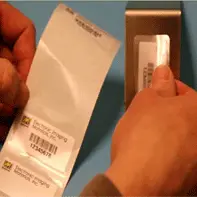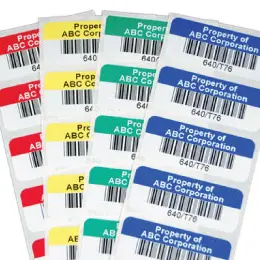Understanding the Differences in Plastics

To many people, it may be hard to think of labeling as a “science,” but the truth be known, it takes a good amount of technical background to solve tough label applications. For instance, one common question we will ask a customer when they come to us with a special label requirement is “What are your labels going to be applied to?”
It is important that we marry the right label adhesive to the specific type of surface in order to assure the best bond and permanence. Typical responses for types of surfaces may be metal, glass, cardboard or plastic, but then we have to dig deeper. Metals can range from polished or painted to uneven and rusty; glass can be smooth, textured or frosty, while cardboard can be uncoated or waxed. When it comes to plastics, the variations are far more diverse. Plastics cover a wide range of synthetic or partially synthetic moldable polymers, most commonly derived from petrochemicals.
It’s interesting to think that the use of plastics only goes back about 100 years and really didn’t get a lot of attention until after World War I when they proved to be highly economical alternatives to metal, wood and glass. Fortunately, as environmental concerns developed and recycling became more important to consumers, the Society of the Plastics Industry (SPI) created a classification system making it easier to sort and dispose of different kinds of plastics. This coding system involves what is called a SPI code with a “chasing arrow symbol” that must be molded or imprinted into the bottom of plastic products.
The SPI System also helps EIM classify different types of plastics, and in doing so, better categorize inherent characteristics that can affect adhesive bonding. The technical data sheets that Electronic Imaging Materials, Inc. creates for each of our label materials may refer to one or more of these specific plastic surfaces.
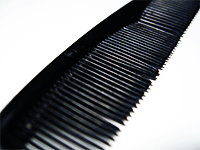
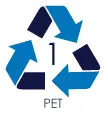
PET (or PETE) – aka Polyethylene Terephthalate. This is the easiest and most common type of plastic to recycle. It is used in household containers such as carbonated beverage bottles, microwavable food trays, and peanut butter jars; as well as medicine bottles, hair combs, and rope. When recycled it is commonly found in carpet, fiberfill for coats and sleeping bags, cassette tapes and sails for boats. In labs, this is primarily used for storage and dispensing bottles.
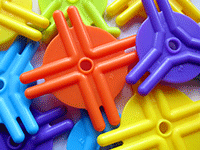
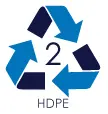
HDPE – aka High-Density Polyethylene. Many packaging applications use this material as a moisture barrier and for its chemical resistance. Safer than PET, products made of HDPE will not transmit chemicals into food or drinks so they are typically used in snack food packages, cereal box liners, milk, margarine and whipped topping containers. It is also used for shampoo, detergent and bleach bottles, motor oil and even children’s toys. When recycled, HDPE is used for plastic lumber, fencing, or storage crates. Like PET, it is commonly found in lab bottles and larger chemical storage containers.


V – aka PVC or Polyvinyl Chloride. This is commonly used in plumbing pipes, floor coverings and house siding, but is also found in synthetic leather products, shower curtains, car dashboards and cable and wire sheathing. Due to its ability to resist most chemicals and bacteria, it is found in blood bags and medical tubing.
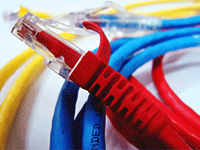
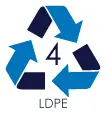
LDPE – aka Low-Density Polyethylene. A durable, flexible plastic known for its transparency and toughness, it is often used for sandwich bags, cling wrap, squeeze bottles, grocery bags and dry cleaning bags. It is also popular in wire and cable applications because it has stable electrical qualities. It is not commonly recycled, but can be used in lumber, garbage cans, and furniture. Like other PE products, this is often used in lab bottles, particularly ones with narrow necks such as wash and dropper bottles.

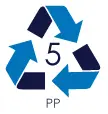
PP – aka Polypropylene. A strong film with excellent chemical resistance, this is a popular synthetic for both solid and flexible packaging. It can handle higher temperatures so is especially good for filling hot liquids such as pancake syrup. It is used for food storage containers, ketchup bottles, diapers, prescription bottles and yogurt containers, as well as plastic bottle caps. It is also found in automotive battery casings. When recycled, it is commonly used in rakes, battery cables or ice scrapers. Due to its wide service temperature range it is one of the most popular plastics used in laboratory test tubes, vials, bottles, jars, racks and microplates.

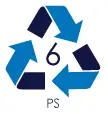
PS – aka Polystyrene or Styrofoam. This plastic can be used in either rigid or foam format. Because of its clarity it is great for medical and laboratory specimen containers such as culture tubes, Petri dishes, pipettes, wells and microplates. It is popular in food packaging and plastic cutlery; as expandable foam, it can be easily shaped into disposable coffee cups, meat, fish and cheese trays and restaurant take-out boxes. It is also popular for packaging foam and peanuts. When recycled it is used for insulation, rulers and license plate frames.
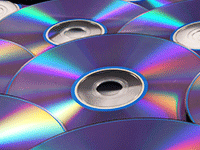
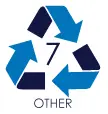
OTHER – Covers all other plastics which are hardest to recycle. Here are a few examples: Acrylonitrile Butadiene Styrene (ABS), known for its strength and rigidity, is used in musical instruments, golf club heads, automotive trim and bumpers, luggage and small kitchen appliances.
Nylon was originally developed as synthetic alternative for silk stockings and is now found in many fabrics including carpet. As a solid, it is used in mechanical parts like screws and gears with low to medium stress levels. It is also used as a reinforcing agent in composite materials for car components. Other applications include hair combs and tooth brushes.
Polylactide (PLA) is made from renewable resources like corn starch, tapioca and sugarcane and thus is used in disposable cups and biodegradable packaging, compost bags, disposable tableware, and non-woven textiles for upholstery, garments and diapers.
Polyester (PET) is popular in knit fabrics, pillows, tarps, bottles and insulating tapes. It can also be found as finishes on wood products like guitars and pianos.
Polymethyl Methacrylate (PMMA) is an acrylic “glass” commonly sold under trade names such as Plexiglas® and Lucite®. Safety glasses are made from PMMA.
Polyurethane (PUR & PU) is found in foam seating, insulation panels, Spandex® clothing, seals and gaskets, hoses and skateboard wheels. While difficult to recycle “other” plastics, PUR can be reused for lumber alternatives.
Polytetrafluoroethylene (commonly sold as DuPont’s Teflon®) is used in cookware, waterproof coating, plumbing tape and tubing due to its strong, heat-resistant, frictionless surface. It’s also used in lab centrifuge tubes.



